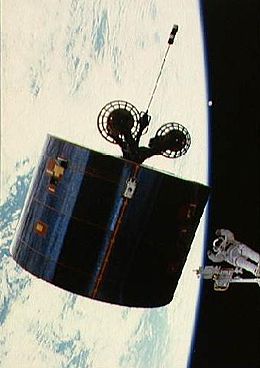 van Hoften next to the crippled Syncom IV-3 (Leasat-3) satellite, during the mission's first EVA. | |
| Names | Space Transportation System-20 |
|---|---|
| Mission type | Satellites deployment Satellite repair |
| Operator | NASA |
| COSPAR ID | 1985-076A |
| SATCAT no. | 15992 |
| Mission duration | 7 days, 2 hours, 17 minutes, 42 seconds |
| Distance travelled | 4,698,602 km (2,919,576 mi) |
| Orbits completed | 112 |
| Spacecraft properties | |
| Spacecraft | Space Shuttle Discovery |
| Launch mass | 118,981 kg (262,308 lb) |
| Landing mass | 89,210 kg (196,670 lb) |
| Payload mass | 17,540 kg (38,670 lb)[1] |
| Crew | |
| Crew size | 5 |
| Members | |
| EVAs | 2 |
| EVA duration |
|
| Start of mission | |
| Launch date | August 27, 1985, 10:58:01 UTC (6:58:01 am EDT) |
| Launch site | Kennedy, LC-39A |
| Contractor | Rockwell International |
| End of mission | |
| Landing date | September 3, 1985, 13:15:43 UTC (6:15:43 am PDT) |
| Landing site | Edwards, Runway 23 |
| Orbital parameters | |
| Reference system | Geocentric orbit |
| Regime | Low Earth orbit |
| Perigee altitude | 350 km (220 mi) |
| Apogee altitude | 465 km (289 mi) |
| Inclination | 28.45° |
| Period | 92.00 minutes |
| Instruments | |
| Physical Vapor Transport Organic Solid Experiment (PVTOS) | |
 STS-51-I mission patch  Back row: James D. A. van Hoften, John M. Lounge, William F. Fisher Front row: Joe H. Engle, Richard O. Covey | |
STS-51-I was the 20th mission of NASA's Space Shuttle program and the sixth flight of Space Shuttle Discovery. During the mission, Discovery deployed three communications satellites into orbit. The mission launched from Kennedy Space Center, Florida, on August 27, 1985, and landed at Edwards Air Force Base, California, on September 3, 1985.
- ^ "STS-51-I Press Kit" (PDF). NASA. February 11, 2015.
 This article incorporates text from this source, which is in the public domain.
This article incorporates text from this source, which is in the public domain.